JDAM e GLSDB: meraviglie o vaporware? Un breve approfondimento su questi due sistemi e sulle possibilità che hanno di contrastare l’AD a strati della Russia._di SIMPLICIUS THE THINKER

In calce la traduzione in Italiano_Giuseppe Germinario
JDAMs And GLSDBs – Wunderwaffen Or Vaporware?
A brief deep-dive into these two systems, and what chances they stand against Russia’s layered AD.

The U.S. has announced a weapons package to Ukraine which includes the JDAM bomb system. The JDAM system is basically an adaptation fitted to older style Vietnam-era Mark 80 series ‘dumb bombs’ (no guidance) which turns them into guided bombs.
There are so many wrong-headed generalizations and jumps to conclusions about these upcoming weapons systems. Let’s explore what this actually means for Russia, and what real consequences can be expected, point by point.
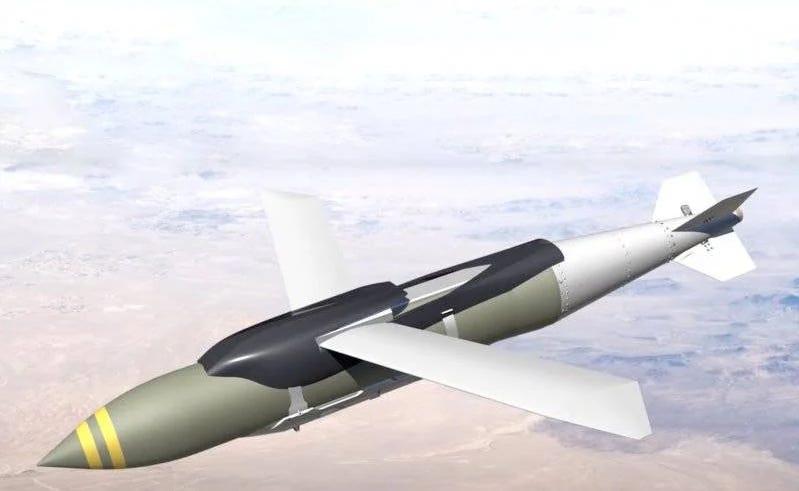
Firstly, a basic primer on what the ‘JDAM-ER’ promised to Ukraine really is. It’s a conversion package which takes an old, basic US ‘Mark 80’ series non-guided bomb and puts a GPS package onto it, with foldable wings, which allows the bomb to ‘glide’ to its target by way of GPS coordinates (and internal INS, but we’ll get to that later). This Mark 80 series has four different types of bombs, 250lbs, 500lbs, 1000lbs, and 2000lbs—and they can all be converted into JDAMs.
This allows the US to quickly convert thousands of old and useless ‘dumb’ bombs into more modern ‘guided’ versions. The platform is extremely cheap, even with the addition of the guided components, and so in that respect it’s perfect for Ukraine. The ‘ER’ designation at the end of JDAM-ER refers to an ‘extended range’ version, which can go upwards of ~72km.
But here’s the catch, the JDAM is a glide bomb—this means it has no propulsion whatsoever, it simply glides to target, always bleeding speed and altitude along the entire way. Think of a thrown paper plane:

This means that to maximize distance, you have to drop it from as high an altitude and as fast a speed as possible.
Many AFU supporters on the net have frothed over the 72km+ range, believing that the bomb will give Ukraine unparalleled capability to strike deep behind Russian lines, completely ignoring the fact that its range is entirely conditional on how the bomb is released.
To hit the full 70km+ range, the host plane would have to be flying very fast to give the bomb a high initial speed, and drop it from 35,000ft altitude.
The problem here is obvious: any AFU plane that ascends to 35k feet would be instantly lit up on every long-range Russian radar screen. This is why neither side in this conflict dares fly above a few hundred feet from the ground. If you drop the bomb from let’s say 5,000ft, its range may top out at a pitiful 10km or less, etc.
But there’s a few nuances to this:
Firstly, there could be the possibility, with really good pilots, that one can creep up towards the frontline at an extremely low altitude—below radar coverage—then very rapidly climb up towards 30k+ feet to release the ordnance, followed by an immediate dive back below radar coverage.
This is conceivable, in theory: and modern jet fighters could climb to 30k in maybe 60 seconds or less, like so:
But there’s a few hitches. Firstly, even the 60 seconds it could take to achieve this climb is a really long time for long-range AD like S300/400 to be able to spot and engage you. During the entire climbing phase, you’ll be on their radars and they’ll be honing the firing solution onto you.
And the biggest thing: by climbing so steeply and rapidly, you will bleed off all your speed. By the time you reach the 30k+ required, you’ll likely be going less than 150-200knots and, after straightening out, will now need an additional ~60 seconds—if not longer—to accelerate the JDAM to its ideal velocity, prior to release; remember, it has no propulsion of its own at all.
In short, this could put you at a theoretical 2 minutes of time stuck in the red ‘danger zone’ of detection (plus additional time for your subsequent ‘dive’ back to safety).
This should give a lot of time for S300/400 operators to fire on you. And even if you manage to dive below radar horizon afterwards, the missile may already be close enough (depending how far away it’s fired from) to have switched to its own terminal guidance. Depending on which missile is used: an S300 can have terminal IR guidance, which means the missile will seek the target by thermal (heat) emission, even if the target is no longer within radar view of the radar base unit far away.
S400 missiles on the other hand have full blown active radar terminal guidance, which means they no longer even need the original tracking/targeting radar on the ground, but will now be tracking the AFU plane with their own in-built nose-cone radar. And it won’t matter how ‘low’ the target tries to go at that point.
An S400 missile’s speed is around 2200mph (3500km/h+), or over Mach 3. So, let’s say the unit detects this hypothetical Ukrainian Mig-29 at max range of around 400km. It would take the S400 missile ~6-7 minutes to reach the target, which could give the plane enough time to evade.
But if the S400 system is anywhere within 100-200km of the detected launch, it brings that down to 2-3 minutes. And as we established, the plane may take nearly 2 full minutes or more of being in the ‘detection zone’ to perform the maneuver required to release the JDAM-ER for a max range hit.
So, if the Russian long range system is anywhere within 100-200km, then they will have a very good chance of shooting down the Ukrainian plane. If it’s anywhere closer than 100km then it would be an almost definite kill. And there’s good chance that there will always be a Russian long range system at least somewhere 100-200km away, if not much less.

Short range systems like Pantsir-S1 and Tor-M1/2 can generally engage targets in the 15-30km range at the most. Medium range systems like BUK around ~30-42km. That means the plane could theoretically launch the JDAMs far out of SHORAD (Short Range AD) range—he would just have to hope that Russia’s layered/integrated long range system is not somewhere in the general region as well.
But what if Ukrainian pilots compromise between range/risk? They could theoretically loft the planes only up to 10-15k feet and release the bombs for maybe half the range of ~30km+. But the issue with this halfway measure is: what would be the point of using a JDAM to reach 30km when they already have a plethora of artillery systems that can do the same thing far cheaper and easier?
Most artillery caps out in the 25-30km range, with a few special RAP/Base-Bleed munitions which can go a tad farther. But thus far, the AFU has had only one weapon system that could reliably go beyond 70km+, and that’s the HIMARS.
Logically, one would think the whole point in obtaining these new JDAM-ERs would be to give Ukraine a solid new method of hitting those HIMARs ranges. It’s difficult to imagine they’d want to settle for merely using the JDAMs in an artillery style role.
Sure, they still would have advantages in that the bombs are exponentially more powerful than artillery. The 500lbs Mark 82 has about 190lbs of explosives, whereas the typical M795 155mm artillery projectile is filled with ~25lbs of explosives.
Also, the JDAM would be much more accurate, as it’s GPS/INS guided, unless you compare it to the GPS-guided Excalibur artillery round with the same accuracy.
Still though, it feels like far too much effort and risk to basically throw a more powerful artillery round at the same distance. After all, Ukraine doesn’t have many planes left; it wouldn’t be worth risking the last few just to heave a round at something that regular artillery could hit.
So I could only imagine they want the JDAMs for max range. After all, it’s why they’re specifically acquiring the JDAM-ER (extended range) model. That means the Ukrainian pilots will be at severe risk trying to lob these things from 35k feet, which leads me to conclude this weapon will not be effective or something to much worry about.
Secondly, we haven’t even mentioned the bomb itself in this regard. Let’s suppose for an instance, the Ukrainian pilots are able to successfully loft it from 35k feet and evade detection. The JDAM itself is a huge, clunky, old-fashioned Vietnam-era bomb. It’s not designed to be ‘low profile’ or ‘low observable’ or ‘stealthy’ or any other of these MIC buzzwords.
Further, it is slow, has an extremely predictable glide path with zero evasive or ‘juking’ capabilities like some modern missiles possess. It will glide subsonically, at an easily predictive path, bleeding speed all the way. In short: it should be one of the easiest possible birds to kill for Russian AD of all the types of munitions currently in use in Ukraine.

Recall, Russian AD now regularly intercepts even HIMARS missiles, sometimes at 100% intercept rate—and these travel at nearly Mach 3.0. How difficult would a giant, clunky bomb floating at Mach 0.4 or less be to shoot down?
Sure, the CIA mission planners will specifically choose to use it where Russian AD may be thin (by way of their satellite recon). But as a generality, these things should not pose much threat at all for the variety of reasons given above.
And the fact that AFU barely has any planes left means they will be exposing their airforce to existential risk each time they attempt to loft these things from the required altitude—barring any sudden mass F-16 deliveries, or something like that. But, just as this U.S. congressman recently said, the F-16 would be completely useless against Russian AD. Watch this video at the 1:40 mark.
Additionally, the JDAM’s accuracy is over 100ft CEP if the GPS is jammed, as it then relies completely on the INS (Inertial Navigation System). And Russia has GPS jamming in much of its most critical areas, which could mean if the JDAM is used against any ‘important’ Russian targets, its accuracy will be very poor.
Lastly, due to how few planes UA has left, and the fact that probably 4 maximum JDAMs will be fitted per plane (similar to F-16), it would not allow Ukraine to conduct the type of long range ‘saturation’ strikes they enjoyed with the HIMARS, of which they have 20 systems total, and which fire 6 missiles each (not to mention the HIMARS’ range is greater than the JDAM to begin with).
But since we’re on the topic of HIMARS, let’s turn to the GLSDB hybrid bomb/missile, which is the other buzzy vaporware Wunderwaffen currently slated to ‘turn the tide’ of the conflict.
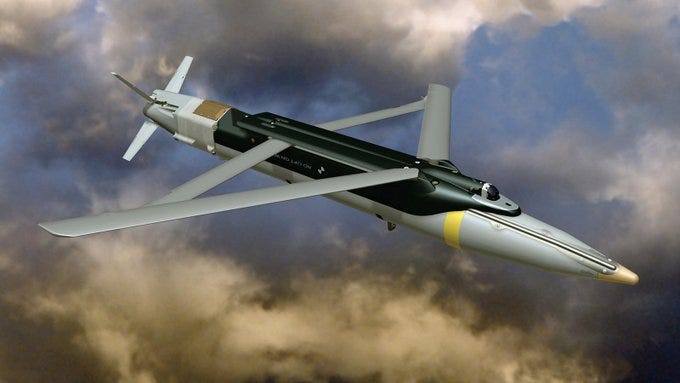
The GLSDB (Ground Launched Small Diameter Bomb) is basically a HIMARS missile with a glide-bomb fitted to the top of it. The purpose of doing this is as follows: the HIMARs themselves have a max range of 80-90km. But if you fit a gliding bomb on top of the missile, shoot the missile high up in the air and release the glider, it can get an even greater extended range—which is 150km.
It can theoretically hit any part of Russian-controlled territory of Donbass if fired from near the contact lines, as seen below:

The glide bomb portion (SDB) is not too dissimilar from the JDAM discussed above. Although its weight is ~250lbs vs. the JDAM’s 500lbs (JDAMs have different variants, but the more popular 500lber is likely the one Ukraine will get).

The SDB is also GPS/INS guided, so no difference there. In terms of its profile, since it’s smaller and a little more modern, it will present a smaller radar cross-section. And since the missile releasing it will be going much faster than the plane subsonically releasing the JDAM, the initial velocity of the GLSDB will be much greater.
However, just like with the JDAM, its speed will slowly bleed off. Since the HIMARS rocket motor’s max range is 90km, and the GLSDB is listed at 150km, you can assume the remaining 60km difference would be entirely traversed by gliding down.
So, even if it’s released supersonically, after dozens of kilometers, it will bleed a lot of speed and most likely end up subsonic by the time it reaches the target.
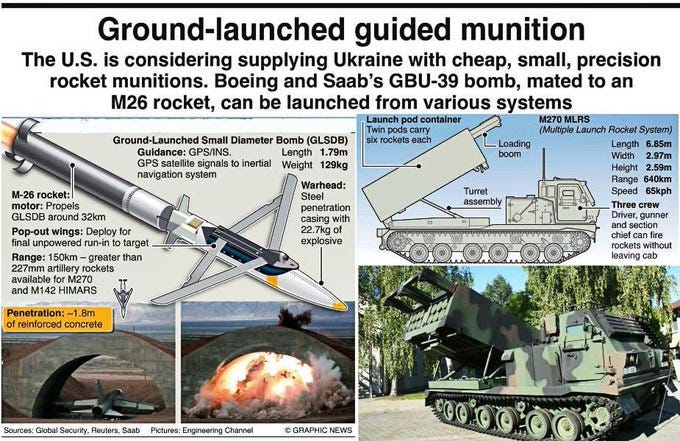
Thus, its interception vulnerability is still fairly high BUT, the difference is that Ukraine would theoretically have much greater ‘saturation’ potential with this. As mentioned earlier, with ~20 HIMARS/M270 vehicles which can launch 6 each (M270 can do 12), there is far greater ability to saturate, making this weapon far more potentially deadly than the JDAM.
However, apparently the U.S. military itself doesn’t even yet operate the GLSDB. They’ve tested them in the past, but they don’t have any current operational systems in service. And according to various sources, the Ukrainian HIMARs are therefore likewise not compatible with them and would take ‘up to 9 months’ to get them retrofitted.

So, how do we reconcile that with the fact that pro-Ukrainians (and some reputable Russian channels as well) claimed that Mariupol was already struck with GLSDB’s last week? From the very moment those ‘strikes’ occurred, I was vocally skeptical that GLSDB’s were utilized, and I remain so.
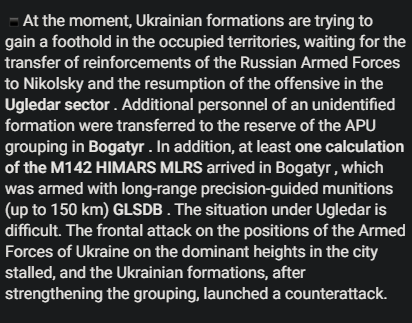


📽️Russian air defense activated in occupied Donetsk, Makiivka and Mariupol. #UkraineRussiaWar https://t.co/M3BWaQvRs7
Firstly, even if they were GLSDB, there has been zero confirmation of any successful hits—only ‘sounds’ of explosions which was likely them being intercepted. If that’s the case, it would be an extremely favorable outlook for Russian AD’s ability to handle these bombs.
The only unverified report which seemed to claim a possible hit was that of the Mariupol airport, which is actually several kilometers west of Mariupol city proper.
Some have stated it had to be GLSDB because nothing else could have reached Mariupol from Ukrainian territory. But it can be seen here that even Ukrainian-occupied Ugledar is a mere 80km from Mariupol:
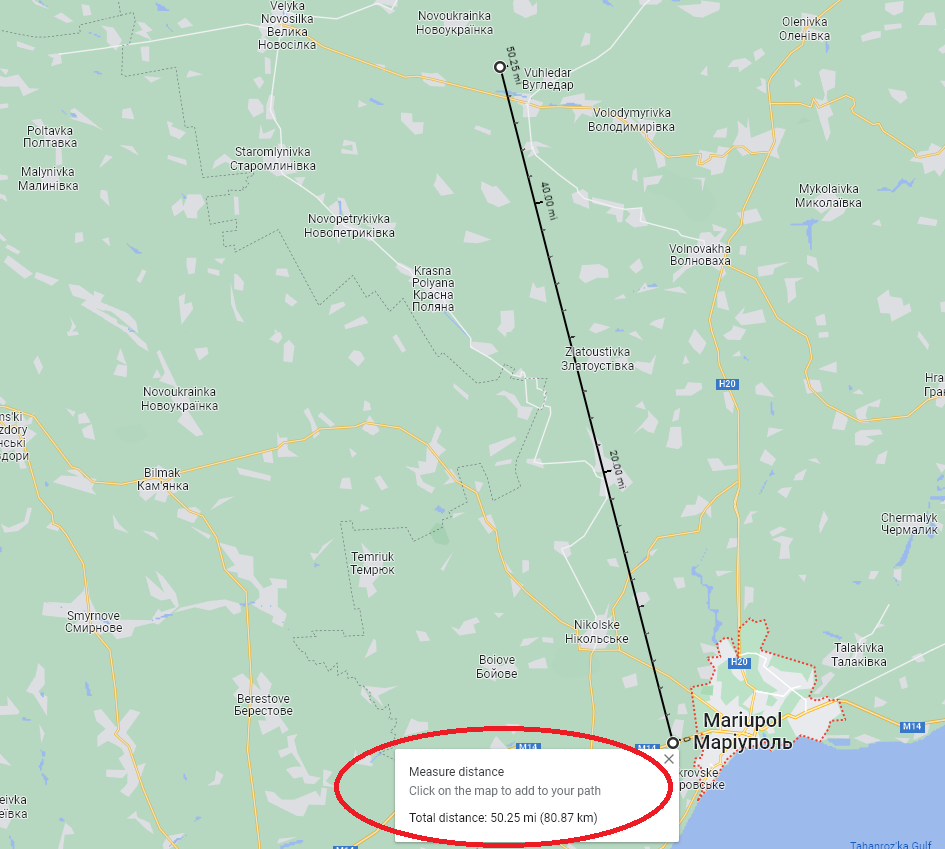
Regular, basic HIMARs missiles have a range of ~90km. So certainly they could have reached—no need for GLSDB.
Lastly, if they had actually been supplied with GLSDB’s already, you would think they’d attempt to hit more than a few insignificant, militarily useless civilian targets in Mariupol. Where are all the terrifying ‘mass, disabling strikes’ on ‘Russia’s rear’?
And why haven’t there been further strikes since then? This hit was already close to two weeks ago. Why aren’t these magical GLSDB’s flooding every frontline, destroying all ‘Russian command centers’ like they were hyped to do? Most likely they don’t have them yet—and there’s good chance they won’t get them.
If they do, it’s likely that they’ll prove about as effective as the AGM-88 HARM(less) missiles have proven. A slow-moving, unmaneuverable glide-bomb will present an easy target for AD even in attempted saturation mode. It’s not a cruise missile which can smartly fly ‘under the radar’—these things will be released extremely high up and will float down like a paper airplane. It’s about as ideal a target as Russian AD can possibly hope for. The only conceivable threat is a saturation attack fired from many HIMARs units at the same time.

Also, it should be mentioned that for both of these systems, it opens up a far larger variety of vectors from which Russian AD can intercept them. When a target is traveling supersonically, let’s say Mach 2-3 range, it’s improbable to intercept it if the AD system is positioned at a vector which makes it difficult for the intercepting missile to ‘catch up.’
Most intercepting missiles, like those of the S400 mentioned earlier, fly in the range of Mach 2-3 themselves. So when you get a missile like a HIMARs that flies at Mach 2.5, the best chance you have of intercepting it is if it’s flying ‘roughly’ toward the general direction of the AD system. This would be a direct vector that’s easy to intercept.
But an oblique vector, where the enemy missile is flying parallel to the hypothetical S300/400 will be much harder. There’s some advanced trigonometry to this, but we’ll simplify it in the most basic possible terms.

In the above very basic diagram, you can see a HIMARs M31 missile traveling at Mach 2.5 in a direction parallel to the S300/400 unit. Let’s say the distance between them might be several dozen kilometers, etc.
The S300/400 missile also traveling at Mach 2.5 will have a very hard time ‘catching up’ with the HIMARS one, unless it were flying ‘directly over’ the S300/400 unit, or fairly adjacently close.
But now:

If the JDAM (or GLSDB for that matter) is flying in the same parallel vector, but it’s only going a small fraction of Mach 1—which is what the bombs will slow down to—you can see that even if the plotted vector is distantly parallel to the S300/400 unit, the missile traveling at Mach 2.5 which is several times faster, will be able to ‘catch up’ with the target.
So basically: it means that JDAMs and GLSDB’s will allow a far greater envelope of engagement and interception vectors for Russian air defense systems of all kinds, whereas faster missiles like the HIMARS enjoy the ability to exploit certain ‘chinks in the armor’ that lie in between overlapping AD system’s radar nets.
In conclusion: while the GLSDB poses more danger, it’s also a far more untested system, which could take much longer to field. As always, it’s not an ‘all or nothing’ binary argument. The systems are not completely worthless—nothing is, in war. They may even get a few strikes, particularly early on before Russian engineers are able to update their new target tracking profiles into the AD radar unit computers, as they recently did with the HIMARS.
But certainly, neither of the systems will prove to be ‘game changers’ of any kind—except of course, as per the AFU’s usual M.O.—against civilian targets in non-military directions which may have radar gaps.
JDAM e GLSDB: meraviglie o vaporware?
Un breve approfondimento su questi due sistemi e sulle possibilità che hanno di contrastare l’AD a strati della Russia.
SIMPLICIUS IL PENSATORE
2 MAR 2023
Gli Stati Uniti hanno annunciato un pacchetto di armi per l’Ucraina che comprende il sistema di bombe JDAM. Il sistema JDAM è fondamentalmente un adattamento delle vecchie bombe dell’era del Vietnam della serie Mark 80 (senza guida) che le trasforma in bombe guidate.
Ci sono così tante generalizzazioni errate e salti alle conclusioni su questi sistemi d’arma in arrivo. Analizziamo punto per punto cosa questo significhi effettivamente per la Russia e quali conseguenze reali ci si possa aspettare.
In primo luogo, una premessa di base su cosa sia realmente il “JDAM-ER” promesso all’Ucraina. Si tratta di un pacchetto di conversione che prende una vecchia bomba statunitense di base della serie “Mark 80” non guidata e la dota di un pacchetto GPS, con ali pieghevoli, che consente alla bomba di “planare” verso il bersaglio grazie alle coordinate GPS (e all’INS interno, ma ci arriveremo dopo). La serie Mark 80 ha quattro tipi diversi di bombe, da 250 libbre, 500 libbre, 1000 libbre e 2000 libbre, e tutte possono essere convertite in JDAM.
Ciò consente agli Stati Uniti di convertire rapidamente migliaia di vecchie e inutili bombe “mute” in versioni “guidate” più moderne. La piattaforma è estremamente economica, anche con l’aggiunta dei componenti guidati, e quindi sotto questo aspetto è perfetta per l’Ucraina. La designazione “ER” alla fine di JDAM-ER si riferisce a una versione “a raggio esteso”, che può raggiungere i 72 km.
Ma ecco l’inghippo: il JDAM è una bomba di planata, cioè non ha alcuna propulsione, semplicemente plana verso il bersaglio, perdendo sempre velocità e altitudine lungo tutto il percorso. Pensate a un aereo di carta lanciato:
Questo significa che per massimizzare la distanza, bisogna lanciarla dalla massima altitudine e alla massima velocità possibile.
Molti sostenitori dell’AFU in rete si sono entusiasmati per la gittata di oltre 72 km, ritenendo che la bomba darà all’Ucraina una capacità senza pari di colpire in profondità dietro le linee russe, ignorando completamente il fatto che la sua gittata è interamente condizionata dal modo in cui la bomba viene sganciata.
Per raggiungere l’intera gittata di oltre 70 km, l’aereo ospite dovrebbe volare molto velocemente per dare alla bomba un’alta velocità iniziale, e sganciarla da un’altitudine di 35.000 piedi.
Il problema in questo caso è ovvio: qualsiasi aereo AFU che salga a 35.000 piedi sarebbe immediatamente illuminato su ogni schermo radar russo a lungo raggio. Questo è il motivo per cui nessuna delle due parti in conflitto osa volare al di sopra di qualche centinaio di metri dal suolo. Se si sgancia la bomba da, diciamo, 5.000 piedi, il suo raggio d’azione può arrivare a un misero 10 km o meno, ecc.
Ma ci sono alcune sfumature in tutto questo:
In primo luogo, ci potrebbe essere la possibilità, con piloti davvero bravi, di avvicinarsi alla linea del fronte a un’altitudine estremamente bassa – sotto la copertura radar – e poi salire molto rapidamente verso 30k+ piedi per sganciare l’ordigno, seguito da una picchiata immediata di nuovo sotto la copertura radar.
Questo è concepibile, in teoria: i moderni caccia a reazione potrebbero salire a 30k in 60 secondi o meno, in questo modo:
Ma ci sono alcuni problemi. In primo luogo, anche i 60 secondi che potrebbero essere necessari per raggiungere questa salita sono un tempo molto lungo per gli AD a lungo raggio come gli S300/400 per essere in grado di individuarvi e ingaggiarvi. Durante l’intera fase di ascesa, sarete sui loro radar e loro affineranno la soluzione di tiro su di voi.
E la cosa più importante è che, salendo così ripidamente e rapidamente, perderai tutta la tua velocità. Quando raggiungerete gli oltre 30k richiesti, probabilmente andrete a meno di 150-200 nodi e, dopo il raddrizzamento, avrete bisogno di altri ~60 secondi, se non di più, per accelerare il JDAM alla sua velocità ideale, prima del rilascio; ricordate che non ha alcuna propulsione propria.
In breve, questo potrebbe portarvi a un tempo teorico di 2 minuti bloccati nella “zona di pericolo” rossa del rilevamento (più il tempo aggiuntivo per la successiva “picchiata” verso la sicurezza).
Questo dovrebbe dare molto tempo agli operatori di S300/400 per sparare su di voi. E anche se in seguito riuscite a immergervi sotto l’orizzonte radar, il missile potrebbe essere già abbastanza vicino (a seconda della distanza da cui è stato lanciato) da essere passato alla propria guida terminale. A seconda del missile utilizzato: un S300 può avere una guida IR terminale, il che significa che il missile cercherà il bersaglio attraverso l’emissione di calore, anche se il bersaglio non è più all’interno della visuale radar dell’unità di base radar lontana.
I missili S400, invece, hanno una guida terminale radar attiva a tutti gli effetti, il che significa che non hanno più bisogno del radar di puntamento/tracciamento originale a terra, ma che ora tracceranno l’aereo dell’AFU con il proprio radar a ogiva incorporato. E non importa quanto “basso” il bersaglio cerchi di scendere a quel punto.
La velocità di un missile S400 si aggira intorno alle 2200 miglia orarie (3500km/h+), ovvero oltre Mach 3. Quindi, diciamo che l’unità rileva questo ipotetico Mig-29 ucraino a una distanza massima di circa 400 km. Il missile S400 impiegherebbe circa 6-7 minuti per raggiungere il bersaglio, il che potrebbe dare all’aereo abbastanza tempo per evadere.
Ma se il sistema S400 si trova entro 100-200 km dal lancio rilevato, il tempo scende a 2-3 minuti. E come abbiamo stabilito, l’aereo potrebbe impiegare quasi 2 minuti interi o più di permanenza nella “zona di rilevamento” per eseguire la manovra necessaria a rilasciare il JDAM-ER per un colpo di massima portata.
Quindi, se il sistema russo a lungo raggio si trova in un raggio di 100-200 km, avrà ottime possibilità di abbattere l’aereo ucraino. Se è più vicino di 100 km, allora sarebbe un’uccisione quasi certa. Ed è molto probabile che ci sia sempre un sistema russo a lungo raggio almeno a 100-200 km di distanza, se non molto meno.
I sistemi a corto raggio come Pantsir-S1 e Tor-M1/2 possono generalmente ingaggiare bersagli nel raggio di 15-30 km al massimo. I sistemi a medio raggio come i BUK si aggirano intorno ai 30-42 km. Ciò significa che l’aereo potrebbe teoricamente lanciare i JDAM ben al di fuori del raggio d’azione dello SHORAD (Short Range AD): dovrebbe solo sperare che il sistema stratificato/integrato a lungo raggio della Russia non si trovi anch’esso da qualche parte in quella zona.
Ma cosa succede se i piloti ucraini fanno un compromesso tra raggio d’azione e rischio? In teoria potrebbero far decollare gli aerei solo fino a 10-15k piedi e sganciare le bombe per una gittata forse dimezzata, pari a oltre 30 km. Ma il problema di questa misura a metà è: che senso avrebbe usare un JDAM per raggiungere i 30 km quando hanno già una pletora di sistemi di artiglieria che possono fare la stessa cosa in modo molto più economico e semplice?
La maggior parte dell’artiglieria raggiunge i 25-30 km, con alcune munizioni speciali RAP/Base-Bleed che possono andare un po’ più lontano. Ma finora l’AFU ha avuto solo un sistema d’arma in grado di andare in modo affidabile oltre i 70 km, e questo è l’HIMARS.
A rigor di logica, si potrebbe pensare che lo scopo dell’ottenimento di questi nuovi JDAM-ER sia quello di fornire all’Ucraina un nuovo metodo solido per colpire le gittate degli HIMAR. È difficile immaginare che vogliano accontentarsi di usare i JDAM solo in un ruolo di artiglieria.
Certo, avrebbero comunque dei vantaggi in quanto le bombe sono esponenzialmente più potenti dell’artiglieria. Il Mark 82 da 500 libbre ha circa 190 libbre di esplosivo, mentre il tipico proiettile d’artiglieria M795 da 155 mm è riempito con circa 25 libbre di esplosivo.
Inoltre, il JDAM sarebbe molto più preciso, essendo a guida GPS/INS, a meno che non lo si confronti con il proiettile d’artiglieria Excalibur a guida GPS con la stessa precisione.
Tuttavia, sembra che ci siano troppi sforzi e rischi per lanciare un proiettile di artiglieria più potente alla stessa distanza. Dopo tutto, all’Ucraina non sono rimasti molti aerei; non varrebbe la pena di rischiare gli ultimi solo per lanciare un proiettile contro qualcosa che l’artiglieria normale potrebbe colpire.
Quindi posso solo immaginare che vogliano i JDAM per avere la massima gittata. Dopotutto, è per questo che stanno acquistando specificamente il modello JDAM-ER (extended range). Ciò significa che i piloti ucraini correranno un grave rischio nel cercare di lanciare queste cose da 35k piedi, il che mi porta a concludere che quest’arma non sarà efficace o qualcosa di cui preoccuparsi.
In secondo luogo, non abbiamo nemmeno menzionato la bomba stessa. Supponiamo, per esempio, che i piloti ucraini siano in grado di lanciarla con successo da 35 metri di altezza e di eludere il rilevamento. Il JDAM è una bomba enorme, goffa e antiquata dell’epoca del Vietnam. Non è stata progettata per essere “a basso profilo” o “poco osservabile” o “furtiva” o altre parole d’ordine del MIC.
Inoltre, è lento, ha una traiettoria di planata estremamente prevedibile e non ha capacità evasive o di “juking” come alcuni missili moderni. Planerà in modo subsonico, con una traiettoria facilmente prevedibile, e la velocità sarà sempre bassa. In breve: dovrebbe essere uno degli uccelli più facili da uccidere per l’AD russo tra tutti i tipi di munizioni attualmente in uso in Ucraina.
Ricordiamo che l’AD russo intercetta regolarmente anche i missili HIMARS, a volte con un tasso di intercettazione del 100%, e questi viaggiano a quasi 3,0 Mach. Quanto sarebbe difficile abbattere una bomba gigante e ingombrante che fluttua a Mach 0,4 o meno?
Certo, i pianificatori delle missioni della CIA sceglieranno specificamente di usarla dove l’AD russa potrebbe essere sottile (attraverso la loro ricognizione satellitare). Ma in generale, queste cose non dovrebbero rappresentare una grande minaccia per le varie ragioni sopra esposte.
E il fatto che l’AFU abbia a malapena degli aerei significa che esporrà la sua forza aerea a rischi esistenziali ogni volta che tenterà di far decollare questi oggetti dall’altitudine richiesta – a meno di improvvise consegne di massa di F-16, o qualcosa del genere. Ma, proprio come ha detto di recente questo deputato americano, l’F-16 sarebbe completamente inutile contro l’AD russo. Guardate questo video al minuto 1:40.
Inoltre, la precisione del JDAM è superiore a 100 piedi CEP se il GPS è disturbato, in quanto si affida completamente all’INS (Inertial Navigation System). La Russia ha il GPS disturbato in molte delle sue aree più critiche, il che potrebbe significare che se il JDAM viene usato contro qualche obiettivo russo “importante”, la sua precisione sarà molto scarsa.
Infine, a causa del numero esiguo di aerei rimasti all’UA e del fatto che probabilmente saranno montati al massimo 4 JDAM per aereo (come per gli F-16), l’Ucraina non potrà condurre il tipo di attacchi a lungo raggio “a saturazione” di cui godeva con gli HIMARS, di cui dispone in totale di 20 sistemi e che sparano 6 missili ciascuno (per non parlare del fatto che il raggio d’azione degli HIMARS è maggiore di quello dei JDAM, tanto per cominciare).
Ma visto che stiamo parlando di HIMARS, passiamo all’ibrido bomba/missile GLSDB, che è l’altro vaporware Wunderwaffen attualmente destinato a “ribaltare le sorti” del conflitto.
Il GLSDB (Ground Launched Small Diameter Bomb) è fondamentalmente un missile HIMARS con una bomba a caduta montata in cima. Lo scopo è il seguente: gli HIMAR hanno una gittata massima di 80-90 km. Ma se si monta una bomba planante in cima al missile, si spara il missile in alto nell’aria e si rilascia la bomba planante, si può ottenere un raggio d’azione ancora maggiore, ovvero 150 km.
In teoria può colpire qualsiasi parte del territorio del Donbass controllato dalla Russia se sparato vicino alle linee di contatto, come si vede qui sotto:
La porzione di bomba a decollo (SDB) non è troppo dissimile dal JDAM discusso in precedenza. Anche se il suo peso è di circa 250 libbre contro le 500 libbre del JDAM (i JDAM hanno diverse varianti, ma il più popolare da 500 libbre è probabilmente quello che l’Ucraina riceverà).
L’SDB è anche a guida GPS/INS, quindi non c’è differenza. In termini di profilo, essendo più piccolo e un po’ più moderno, presenterà una sezione trasversale radar minore. E poiché il missile che lo sgancia andrà molto più veloce dell’aereo che sgancia il JDAM in modo subsonico, la velocità iniziale del GLSDB sarà molto maggiore.
Tuttavia, proprio come nel caso del JDAM, la sua velocità si ridurrà lentamente. Poiché la gittata massima del motore a razzo dell’HIMARS è di 90 km, mentre il GLSDB è quotato a 150 km, si può presumere che i restanti 60 km di differenza saranno interamente percorsi planando.
Quindi, anche se viene rilasciato in modo supersonico, dopo decine di chilometri, perderà molta velocità e molto probabilmente finirà subsonico quando raggiungerà il bersaglio.
Pertanto, la sua vulnerabilità all’intercettazione è ancora piuttosto alta, ma la differenza è che l’Ucraina avrebbe teoricamente un potenziale di “saturazione” molto più elevato. Come accennato in precedenza, con circa 20 veicoli HIMARS/M270 che possono lanciarne 6 ciascuno (l’M270 ne può lanciare 12), la capacità di saturazione è di gran lunga maggiore, rendendo quest’arma molto più potenzialmente letale del JDAM.
Tuttavia, a quanto pare le stesse forze armate statunitensi non utilizzano ancora il GLSDB. Li hanno testati in passato, ma non hanno sistemi operativi in servizio. E secondo varie fonti, anche gli HIMAR ucraini non sono compatibili con essi e ci vorrebbero “fino a 9 mesi” per adattarli.
Quindi, come si concilia questo con il fatto che i filo-ucraini (e anche alcuni canali russi affidabili) hanno affermato che Mariupol era già stata colpita con i GLSDB la scorsa settimana? Dal momento stesso in cui si sono verificati questi “colpi”, sono stato scettico sul fatto che i GLSDB fossero stati utilizzati, e continuo ad esserlo.
Rapporto del canale RYBAR.
Avatar di Twitter per @RWApodcast
Russi con atteggiamento
@RWApodcast
Mariupol è fuori dal raggio d’azione dei normali missili HIMARS, quindi presumibilmente hanno ricevuto un primo lotto di GLSDB, con il primo test di combattimento che consiste nel lanciarli indiscriminatamente contro grandi città. Tasso di intercettazione del 100% finora, nessun “arrivo” segnalato.
Avatar di Twitter per @Militarylandnet
MilitaryLand.net
@Militarylandnet
📽️Russian difesa aerea attivata nelle città occupate di Donetsk, Makiivka e Mariupol.
#UcrainaRussiaGuerra https://t.co/M3BWaQvRs7
10:27 PM ∙ 21 febbraio 2023
1,230
Mi piace
252
Retweet
In primo luogo, anche se si trattasse di GLSDB, non ci sono state conferme di colpi andati a segno, ma solo di “suoni” di esplosioni che probabilmente sono stati intercettati. Se così fosse, si tratterebbe di una prospettiva estremamente favorevole per la capacità dell’AD russo di gestire queste bombe.
L’unico rapporto non verificato che sembrava affermare un possibile colpo è stato quello dell’aeroporto di Mariupol, che in realtà si trova a diversi chilometri a ovest della città di Mariupol vera e propria.
Alcuni hanno affermato che doveva trattarsi di GLSDB perché nient’altro avrebbe potuto raggiungere Mariupol dal territorio ucraino. Ma si può notare che anche Ugledar, occupata dagli ucraini, è a soli 80 km da Mariupol:
I normali missili HIMAR di base hanno una gittata di circa 90 km. Quindi certamente avrebbero potuto raggiungerla, senza bisogno di GLSDB.
Infine, se fossero stati effettivamente forniti di GLSDB, si potrebbe pensare che avrebbero tentato di colpire più di qualche insignificante e militarmente inutile obiettivo civile a Mariupol. Dove sono tutti i terrificanti “attacchi di massa e disabilitanti” sulle “retrovie della Russia”?
E perché non ci sono stati altri attacchi da allora? Questo attacco risale a quasi due settimane fa. Perché questi magici GLSDB non stanno inondando ogni linea del fronte, distruggendo tutti i “centri di comando russi” come si era detto? Molto probabilmente non li hanno ancora – ed è molto probabile che non li avranno.
Se li avranno, è probabile che si dimostreranno efficaci quanto i missili AGM-88 HARM(less). Una bomba planare lenta e non manovrabile sarà un bersaglio facile per l’AD anche in modalità di saturazione. Non si tratta di un missile da crociera che può volare “sotto il radar”: queste cose saranno sganciate molto in alto e voleranno giù come un aeroplano di carta. È il bersaglio ideale che l’AD russo possa desiderare. L’unica minaccia concepibile è un attacco di saturazione sparato da molte unità HIMAR contemporaneamente.
Inoltre, va detto che per entrambi questi sistemi si apre una varietà molto più ampia di vettori da cui l’AD russo può intercettarli. Quando un bersaglio viaggia a velocità supersonica, diciamo a Mach 2-3, è improbabile intercettarlo se il sistema AD è posizionato su un vettore che rende difficile per il missile intercettatore “raggiungerlo”.
La maggior parte dei missili intercettatori, come quelli dell’S400 citato in precedenza, volano essi stessi nel raggio di Mach 2-3. Quindi, quando si ha un missile come quello dell’S400, è improbabile che venga intercettato. Quindi, quando un missile come l’HIMARs vola a 2,5 Mach, la migliore possibilità di intercettarlo è che voli “approssimativamente” verso la direzione generale del sistema AD. Questo sarebbe un vettore diretto facile da intercettare.
Ma un vettore obliquo, dove il missile nemico vola parallelamente all’ipotetico S300/400, sarà molto più difficile. Si tratta di una trigonometria avanzata, ma la semplificheremo nei termini più elementari possibili.
Nel diagramma di base qui sopra, si vede un missile HIMARs M31 che viaggia a Mach 2,5 in direzione parallela all’unità S300/400. Diciamo che la distanza tra i due potrebbe essere di diverse decine di chilometri, ecc.
Il missile S300/400, che viaggia anch’esso a Mach 2,5, farà molta fatica a “raggiungere” il missile HIMARS, a meno che non voli “direttamente sopra” l’unità S300/400, o abbastanza vicino.
Ma ora:
Se il JDAM (o il GLSDB, se è per questo) sta volando nello stesso vettore parallelo, ma sta andando solo a una piccola frazione di Mach 1, che è quello a cui le bombe rallentano, si può vedere che anche se il vettore tracciato è lontanamente parallelo all’unità S300/400, il missile che viaggia a Mach 2,5, che è diverse volte più veloce, sarà in grado di “raggiungere” il bersaglio.
In sostanza, ciò significa che i JDAM e i GLSDB consentiranno ai sistemi di difesa aerea russi di ogni tipo di avere un raggio di ingaggio e di intercettazione molto più ampio, mentre i missili più veloci come l’HIMARS hanno la possibilità di sfruttare alcune “fessure nella corazza” che si trovano tra le reti radar dei sistemi AD che si sovrappongono.
In conclusione, se da un lato il GLSDB rappresenta un pericolo maggiore, dall’altro è anche un sistema molto meno collaudato, che potrebbe richiedere molto più tempo per essere messo in campo. Come sempre, non si tratta di un argomento binario “tutto o niente”. I sistemi non sono completamente inutili – niente lo è, in guerra. Potrebbero anche ottenere qualche colpo, soprattutto all’inizio, prima che gli ingegneri russi siano in grado di aggiornare i loro nuovi profili di tracciamento dei bersagli nei computer delle unità radar AD, come hanno fatto di recente con l’HIMARS.
Ma certamente nessuno dei due sistemi si rivelerà un “game changer” di alcun tipo – tranne ovviamente, come da solito modus operandi dell’AFU – contro obiettivi civili in direzioni non militari che possono avere lacune radar.

